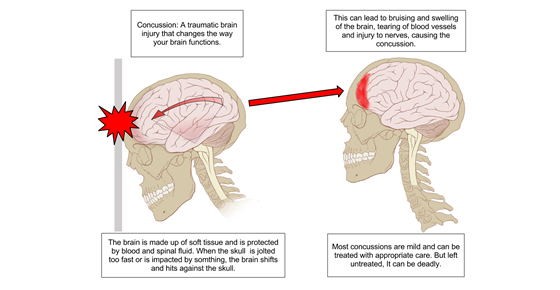
What is actually happening, at a mechanical and physiological level, during a head injury? First thing, the absence of findings on a brain scan or MRI doesn’t necessarily mean that there are no damages. And during a head impact there are actuall 3 distinct mechanisms that are happening. In order to understand that, we must first review the anatomy. The skull is connected to the spine with a condyloid joint (the atlanto-occipital joint), which grossly looks like a sphere that’s pivoting on top of a stick (in reality it’s a little bit more complicated but let’s use this analogy for now). Within that sphere, there is the brain, a very soft, gelatinous-like structure and which is enclosed by a 3-layered protecting sheet called the meninges. The brain is not a uniform structure but is made of more or less dense bundles of neurons that connectwith each other at some relays called nuclei. So here are the 3 different impacts:
1. Skull vs. Surface
That surface can be a wall, the floor, another head, a fist,…basically any hard surface that would abruptly encounter your head at a high speed. That impact will primarily affect the skull, which will absorb as much as it can the force. If that impact is too h3, you have a skull fracture but that’s pretty rare as the skull is one of the most solid bone of the human body.
2. Brain vs. Skull
There is normally very little space between the brain and the skull. The brain is enclosed in the meninges, which contains a fluid called the cerebrospinal fluid (or CSF), whose function is to isolate the brain and the spinal cord. The CSF als supplies nutrients and removes waste products from the central nervous system. During an impact, the meninges and the CSF act like a cushion to protect the brain but if that impact is too fast, that protection won’t be enough and the skull will hit the brain from within and cause an actual bruise of the brain. The inertia will create a back movement of the skull, which will make the back of the brain to hit the back of the skull as a result of that transfer of energy. That mechanism is called the “coup and contre-coup” and can result into what we call focal damage to the brain, usually at the location where the brain hit the skull. One of the major complication of such an injury is intracranial hemorrhage (or bleeding) which is a life-threatening medical emergency.
3. Within the brain
And finally what matter the most to us. This is where the concussion is actually happening. Because of the way the head sticks on top of the spine, the impact will often cause a rotational force to the brain. And because the brain internal structure is not uniform, some neurons will accelerate more than others, causing shearing tears between them at the levels of their axons. This is called diffuse axonal injury: The cell membrane will be stretched or even disrupted, which will lead to a series of neurochemical changes that we will describe in a bit. It is important to note that at this level of injury, it is not necessary to get an impact of the head, but simply a sudden change in speed (or pressure such as during a blast explosion) can affect as much the nerve cells and cause an axonal diffuse injury. This is why a whiplash caused by a car accident for instance can, simply by the inertia caused, lead to a concussion even though the head does not hit anything. In that case, the rapid deceleration can affect the brain and cause as much damages as receiving a direct blunt to the head. Another important detail is that injury is happening at a cellular level, and hence it won’t necessarily show up on a brain MRI due to the absence of large structural damages. Unless the impact is so brutal that the diffuse axonal injury covers a large volume of the brain, in that case some damages can be visible. But as a general rule, this is pretty much what a concussion is: functional neurological deficits without any structural changes or damages.
Conclusion
- A head injury can cause damages at 3 levels
- Concussion is caused by physiological changes within the brain, at the microscopic level, and because of that it won’t necessarily show up in a brain scan or MRI
- You don’t need a direct impact in the brain to have concussive symptoms, a whiplash or accelerative force can also cause damages
